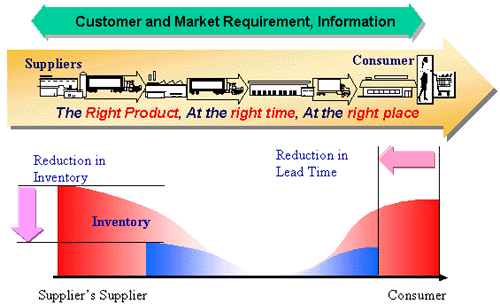
1) General term referring to the body of knowledge and activities concerned with planning and controlling rates of purchasing, production, distribution, and related capacity resources to achieve target levels of customer service, backlogs, operating costs, inventory investment, manufacturing efficiency, and ultimately, profit and return on investment.
2) The planning, scheduling, execution, and control of the process of converting inputs into finished goods.
3) A field of study that focuses on the effective planning, scheduling, use, and control of a manufacturing organization through the study of concepts from design engineering, industrial engineering, management information systems, quality management, inventory management, accounting, and other functions as they affect the transformation process.

The Economic Lot Scheduling Problem (ELSP) is the problem of finding the production sequence, production times and idle times of several products in a single facility(machine) on a repetitive basis so that the demands are made without stockouts or backorders and average inventory holding and setup costs are minimized.

Scheduling allocates resources over time to accomplish specific tasks. Normally, scheduling is done after many other managerial decisions have been made. For example, planning emergency services such as fire protection first requires an analysis of the best location for fire stations, decisions about the type and quantity of fire-fighting equipment at each location, and a staffing plan for each station. Sound scheduling can help an organization achieve its strategic goals.

1) Simulation is the imitation of the operation of a real-world process or system over time to investigate a wide variety of "What-if" questions about the real-world system.
2) Areas of Application : Simulation of the operations at an airport, the passage of the traffic across a juction, inventory control system to determine optimal ordering policies, a telephone communication system to determine the appropriate capacity, and the operation of a production line to determine the amount of in-process storage space or buffer size.

1) The supply chain has been defined as "the network of organizations that are involved, through upstream and downstream linkages, in the different processes and activities that produce value in the form of products and services in the hands of the ultimate customer" and "encompasses all activities associated with the flow and transformation of goods from the raw materials stage (extractions), through to the end user, as well as the associated information flows. Material and information flow both up and down the supply chain"
2) The supply chain management has been defined as “the integration of these activities through improved supply chain relationships, to achieve a sustainable competitive advantage" and "a set of approaches utilized to efficiently integrate suppliers, manufacturers, warehouses, and stores, so that merchandise is produced and distributed at the right quantities, to the right locations, and at the right time, in order to minimize systemwide costs while satisfying service level requirements".

|






